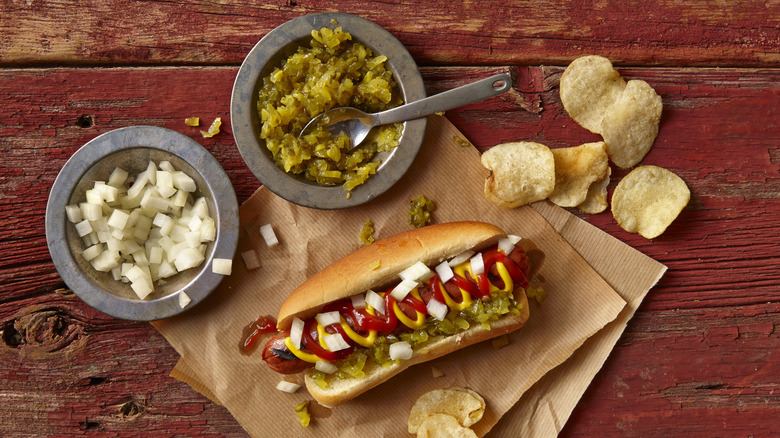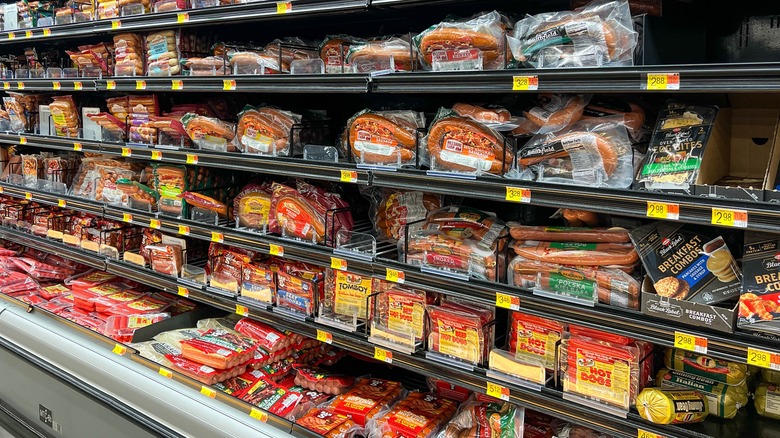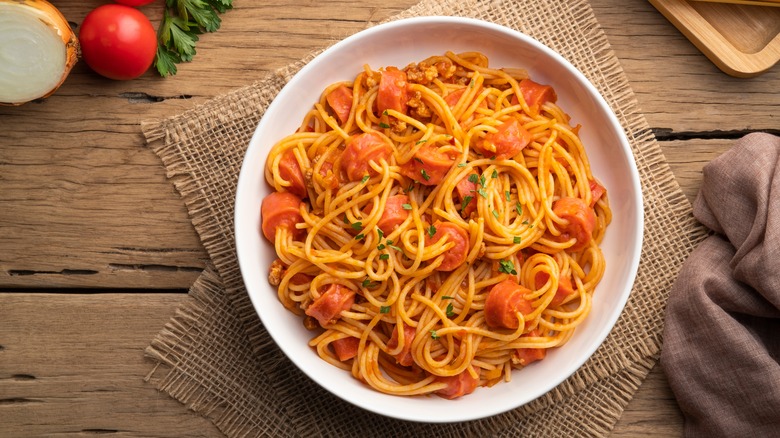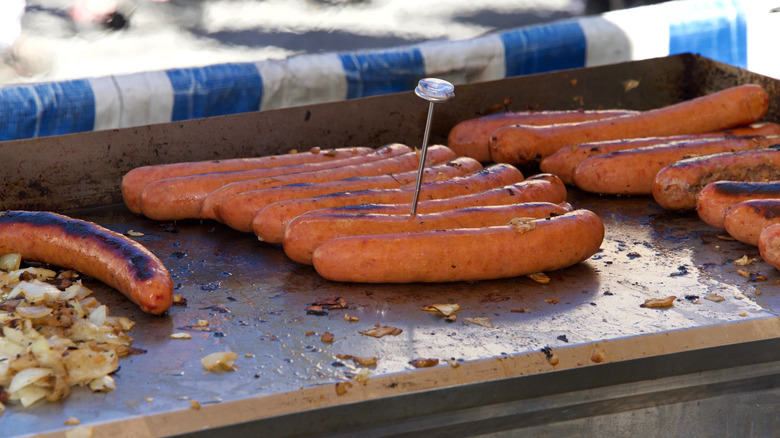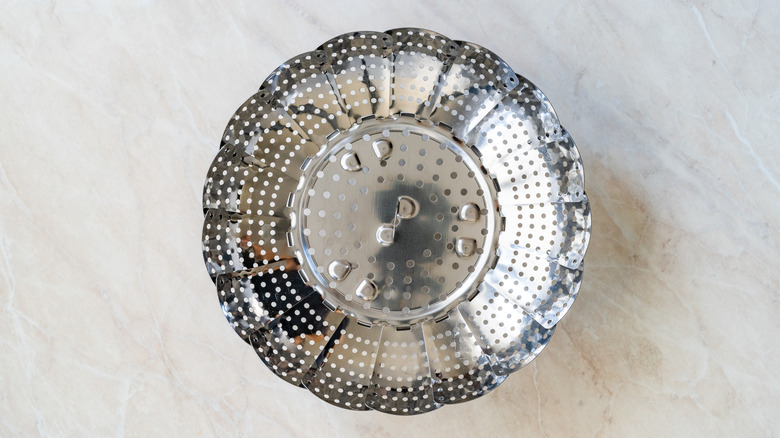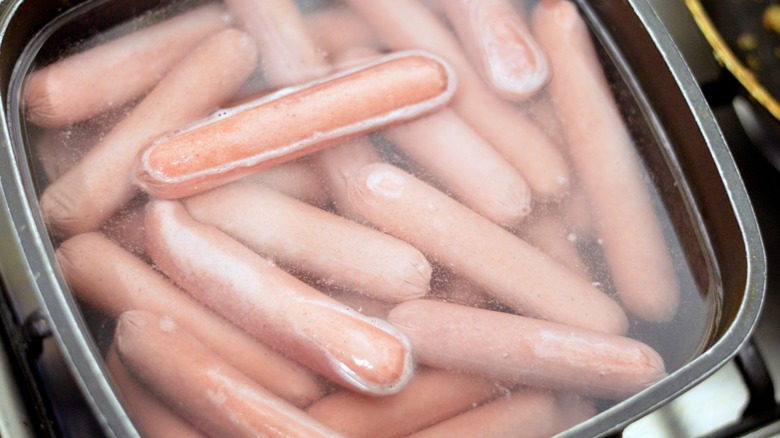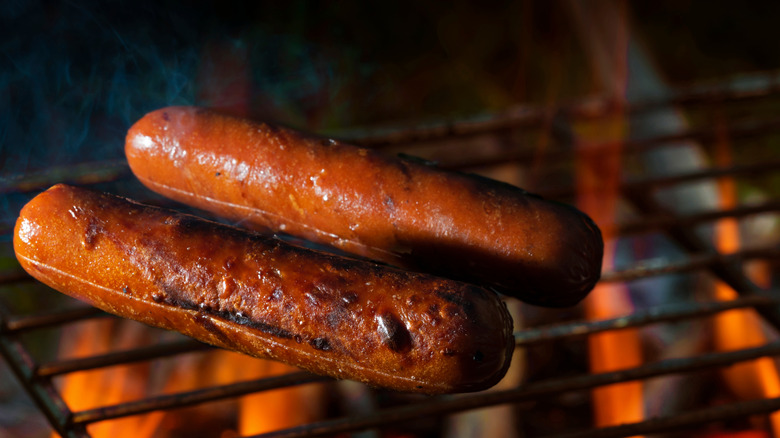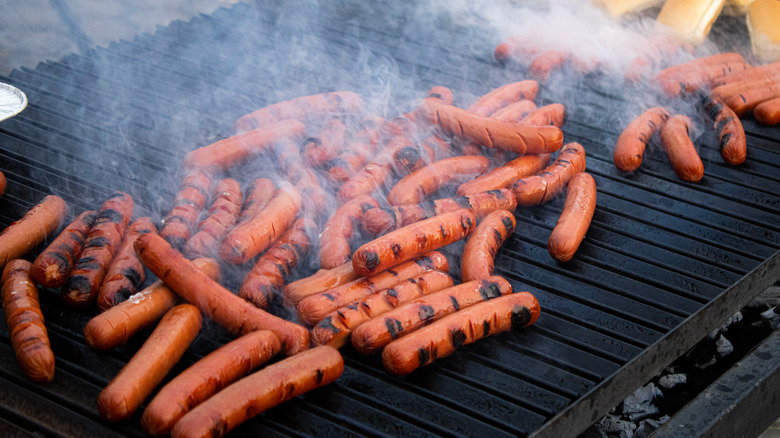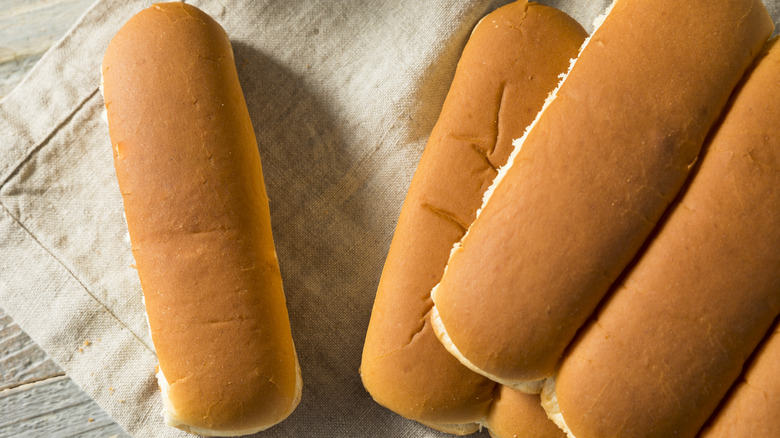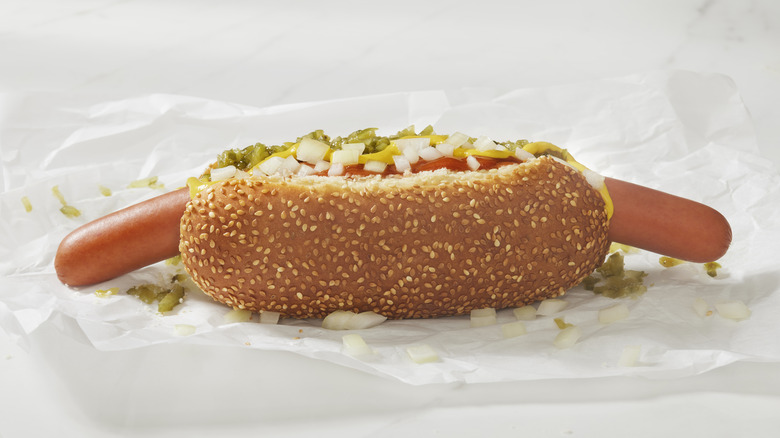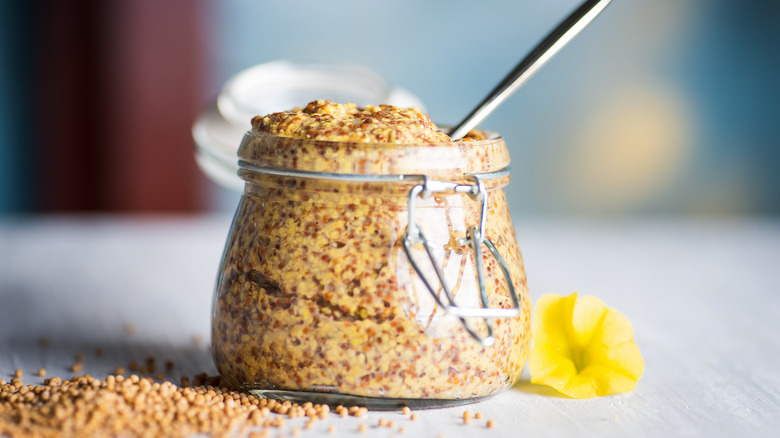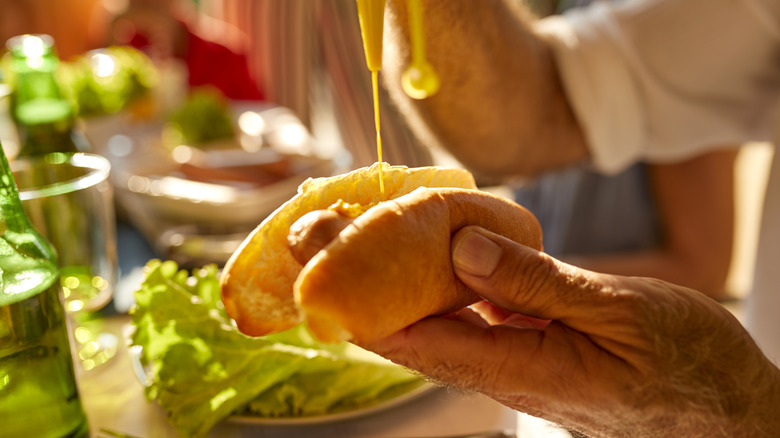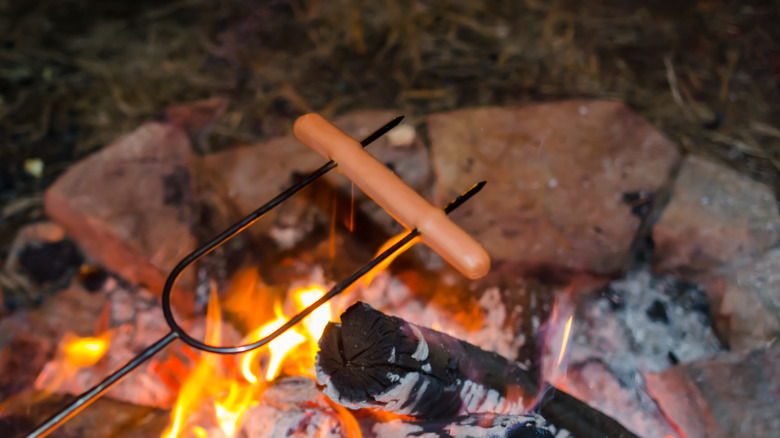13 Hot Dog Mistakes Everyone Needs To Avoid
Hot dogs seem to follow festivities. Take a moment and think of all the places you've enjoyed a hot dog; there's a good chance it's been accompanied by great memories. Perhaps it was one of your first favorite foods, or maybe the perfect dog came from a brightly lit food truck at your town's annual fall festival. Perhaps you're completely convinced that the Chicago dog you've loved since you can remember is the elite dog in the whole country. No matter what those memories are, the good old hot dog certainly has a longstanding tradition at making a home in our sweetest memories.
Unfortunately, there are plenty of ways these frankfurters can go sideways. But never fear, we have you covered with some mistakes that you should avoid when preparing your next batch of hot dogs. Whether it's just a simple weekend meal or a large cookout, we'll make sure those dogs are clear of these unfortunate blunders that could ruin a perfectly tasty bite.
1. Ignoring hot dog quality
If you want to make a great hot dog, you simply must start with a quality brand. Choosing any basic option off the shelf just won't do the trick. Instead, you'll need to do a little homework here and understand exactly what you're looking for.
First off, decide whether you're looking for a natural casing hot dog, a skinless hot dog, or even something that's uncured. From there, you'll want to pay attention to the components of the hot dog options at your local store. Generally, hot dogs that have a more simple ingredient listing are the more quality hot dogs. For example, ones that list an all beef frankfurter will often be the ones that create a better hot dog.
On the other hand, if you prefer something of a mixture, you'll find that there's plenty of those out there, too. Unfortunately, it does seem that price can pay a part in quality, so some of the cheaper hot dogs are often some of the ones that are going to make your hot dog experience suffer. The most important part here is to pay attention to what you're buying. The same old brand you've always purchased might have great name recognition and advertising, but that doesn't mean it's the best hot dog brand on the market.
2. Forgetting creativity
As kids, we remember enjoying hot dogs in many different dishes. They didn't always just appear on a sliced bun. Instead, they were often sliced and cropped up in our mac and cheese for extra protein. Then, there's the classic hot dog and spaghetti squid, a mixture that's as silly as it is iconically a childhood meal. Parents are often keen to discover new ways to help their children get extra protein or try new foods, and creativity is definitely a requirement in these instances. As we grow older, we tend to forget a lot of these fun ways to make meals fun. In fact, one of the biggest mistakes you can make when preparing a hot dog is losing sight of what makes hot dogs fun: their creativity.
Of course, you don't need to resort to hot dog squids made from spaghetti and frankfurters, but there are plenty of hot dog recipes that make a simple ingredient like hot dogs into much more fun. Rachael Ray's hot dog salad, for example, is a cool spin on the classic dragged-through-the-garden dog. It's the perfect example of putting a little life back into your hot dog cooking and dressing.
3. Missing doneness temperature
There are many ways to cook a hot dog, and though they all work to warm your dog, each will create a different casing texture and can significantly impact your overall hot dog experience. Just like other meat products, no matter what cooking method you choose, there is an ideal internal temperature you should set your sights on. So, get your instant read meat thermometer ready, because we encourage you to carefully monitor the temperature of your hot dogs to ensure the best possible experience. That golden number to cook a perfectly done hot dog is 155 F.
This temperature probably seems like a pretty warm hot dog, especially since most hot dogs you purchase will be fully cooked the moment you start making them. But at this temperature, the meat and juices reach a point that will create an optimal eating experience. Many forget to monitor a hot dog's temperature, taking comfort in the fact that it's already cooked. However, it's important to remember that these aren't just leftovers you've pulled from the refrigerator. Taking the time to watch the temperature will pay off for a better hot dog experience.
4. Not steaming dogs
You often see hot dogs cooked with grill marks on them. And while this certainly makes for an attractive dog, one of our favorite ways to cook hot dogs is actually by steaming them. If you've ever had a Chicago style hot dog and you were impressed with its texture, there's nearly a guarantee that it was steamed, as that's the way many Chicago style hot dogs are prepared.
One of the simplest ways to prepare a steamed dog is by getting a steamer basket for a pot. That will fit your hot dogs. Simply fill the bottom of your pot with about an inch of water, let that come to a medium boil, to a point that it is producing steam, and then place your steamer basket in the pot. Be sure the liquid doesn't come above the steamer basket, though. Carefully place your dogs inside the steamer basket, and place a lid over the top. As the dogs warm, check the temperature every now and again to see that you are achieving the desired temperature. We like to pull our steamed dogs at around 155 F. If you want your dogs to have those grill marks on at the end, you could always throw them on the grill for the last few degrees to achieve those marks and get a slightly crispy casing.
5. Boiling your dogs
Many of us might remember boiled hot dogs from our childhood. It's an ultra simple way to cook up hot dogs, but it's not very desirable. Instead of boiling your dogs, you could pan fry them. This will lead to a crispy crust that many enjoy.
To fry up hot dogs, warm up butter in a pan and put in your dogs. Be sure to move them around the skillet to ensure that they reach that consistent temperature, and check for doneness with a meat thermometer. Another great way to cook hot dogs is to start by simmering them in a shallow amount of water for only a couple of minutes before putting them on your grill. Using this method helps cook the hot dog on the inside and give the grill a rounding off time to create the crust. It's similar to the effect of steaming, but the dogs actually get submerged for a period of time.
6. Getting them too hot
No matter the method you choose for cooking your hot dog, it is possible that you can make them too hot, so always bear in mind that these are already cooked meat products. While you do need to cook them, they were already cooked once, so overdoing them can definitely cause a problem.
In fact, overcooking your hot dog can make the casing split in a way that isn't very enjoyable as it will release most of the moisture in the dog. When your casings burst open, you'll certainly know that you've gone too far. A good way to avoid this is by simply using that meat thermometer to frequently check on the temperature of your hot dog, monitoring it to see that you reach that ideal temperature but don't far exceed it. One of the quickest ways to make these casings burst is to cook your hot dogs on a grill that is too hot. Aim for somewhere between 400 F and 425 F for a grill temperature that ensures your casings don't burst on you.
7. Overcrowding your grill
Cooking for a whole lot of people at one time is best achieved on a grill. It's a larger cooking space that can cook a large quantity of food. Due to this sizable cooking area, it can be tempting to cover every inch of your grill, thereby unintentionally overcrowding it. It might seem like you are efficiently preparing food, but what you're actually doing is creating a major hot dog mistake.
When you overcrowd a grill, you lower the overall temperature of your grill and make it difficult to achieve the ideal temperature for your cooked food (a classic grilling mistake). This overcrowding also can lead to the moisture level on your grill becoming so substantial that your food actually streams rather than sears on the grill top. You don't want to end up with your hot dogs cooking in moisture run off on a grill when the opposite is typically the effect you're going for.
8. Using a cold bun
Most people don't even think about buns when they create their hot dog. Of course, you might make some decisions in the store about the quality of your bun, or the bread type, but beyond those couple of decisions, most people miss this component entirely, and this is another hot dog mistake.
Once you finish making your hot dogs, going an extra step and steaming those hot dog buns will make for an even better hot dog experience. Rather than putting them in a steaming basket as you may have done with your hot dogs, you can instead hold your hot dog bun over the same pot you used for steaming your hot dogs and allow them to take in some of that steam. It only takes a couple of seconds, and you certainly don't want to overdo it here, but a few moments in that steam will help soften the bread and make it an even better hot dog.
9. Ignoring bun length
Speaking of hot dog buns, another major mistake you can make when purchasing hot dogs is ignoring the length of the bun you've chosen and how it works with the hot dog you have. When the two elements aren't chosen to go together, the meat to bun ratio can be wildly off. Of course, you want a balance of condiments, meat, and bun with each bite. Instead, we recommend choosing hot dogs and buns that match each other in length.
Of course, you might have your hot dog extending about a half inch on either side, but too much more than that might lead to a less than desirable eating experience. After all, one of the hot dog bun's central tenants is helping you deliver the hot dog and its condiments in an efficient way. Ignoring the bun length doesn't allow this to happen. Taking a few extra moments to notice the hot dogs you are purchasing, as well as how they go with the buns, will remedy this before it becomes a problem.
10. Sticking with basic mustard
If you're sticking gearing up to dress some hot dogs, there's a good chance you have a few staples lined up. Ketchup, relish, onion, and yellow mustard are, no doubt, among your collection. However, there's much more to the world of mustard than the typical, bright yellow variety, and restricting yourself to the mustard you already know could be a mistake.
Take a look at your grocery store condiment aisle. There's a good chance you'll find Dijon mustard, spicy mustard, and a whole slew of other tasty accompaniments that make great additions to hot dogs. This is the perfect place to play and use your creativity to take your hot dogs from good to great. We also love shopping for specialty mustards at markets and other fun shops. Now, if you're making a regionally specific hot dog like a Chicago style dog, do not veer away from its defined element, and stick to what the regional hot dog requires. But if you aren't bound by such constraints, take the time to find some truly unique condiments.
11. Judging regional dogs too harshly
Every region with its own specialty hot dog thinks it has an absolute lock on the hot dog game. Chicago style hot dogs get a hefty amount of toppings and fresh ingredients, looking something like a rainbow on a bun. Over in Cincinnati, eat like a local with a dog piled high with a Cincinnati chili and loads of shredded cheese. Other regional dogs prize pickled concoctions for the topping, and still others, like the Puka Dog from Hawaii, have a special bun and even fruit relish.
While it may be a little counterintuitive at first, try not to judge other regional hot dogs too harshly. If you lock yourself into believing that your region's hot dog is superior to all others, you might be missing out on some great flavors. Of course, you don't need to travel the country to sample America's best regional hot dog offerings. Most regional hot dogs have the ingredients you'll need in your local grocery store. With a simple shopping trip, you can travel the country via hot dog right from your kitchen.
12. Forgetting to shake the condiment bottle
As delicious as hot dogs are, they can become a sensory nightmare pretty quickly. To help avoid this problem, you absolutely must shake your condiment bottles. If you don't, you might end up with extra liquid squirting out from the bottle and onto the bun of your hot dog.
Of course, anyone who loves hot dogs has had this experience, but with one quick hard shake into a kitchen sink or even as you remove your condiments from their storage location, you can help ensure that you and your guests don't walk away with a soggy bun. If the unexpected happens and your condiments do leak onto the bun during dressing, you could always toss out the bun. To this end, it may be worthwhile to have a few extra buns on hand. Shaking the condiments ahead of time is one way to avoid the need of an extra bun to begin with.
13. Missing campfire skewers
Going camping? Don't forget your campfire skewers! Even if you plan on cooking your hot dogs over a grated campfire or a nearby grill, offering a classic way of cooking hot dogs with campfire skewers is a super interactive and enjoyable experience. Plus, it takes some of the cooking pressure off of your designated cook. Everyone can help out and even cook up their own hot dog to a desired temperature. Of course, you'll want to be sure your youngest campers have the care of an older camper helping them get the hot dog cooked just right.
While cooking over an open campfire is super enjoyable, it can, of course, lead to inconsistent cooking temperatures, and that's why we recommend having a meat thermometer on hand to help ensure that hot dogs reach a temperature that would be enjoyable. Before people attack the fire with their campfire skewers, it might be helpful to show off where the meat thermometer is and recommend a slow turning of the campfire skewer while the hot dog hangs out over the fire.
For this process, we highly recommend a double prong skewer rather than a single-pronged one. This way, the hot dog can stay horizontal rather than be vertical over the fire. The best part? Those hot dog skewers can get a nice cleaning and quickly become marshmallow skewers for the perfect dessert.
